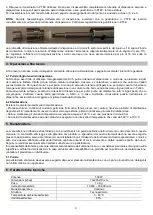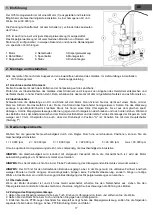
6
3. Remove the PTFE bearing from the axle. After this disassembly you should have the following parts: shaft tube, axle,
rotor, stator, and PTFE sheat.
To assemble the dispersing tool please follow above 3 steps in reverse order. (3, 2 and 1).
NOTE
: During the assembling of the dispersing tool, make sure that the PTFE bearing is between the flange and the nut to
avoid scratching and rubbing marks on the flange. Constantly control the PTFE bearing.
The optimal immersion depth of the dispersing shaft is approximately 2/3 below the liquid surface and 1/3 above the bottom
of the beaker. When inserting the dispersing shaft slightly slanted (approximately at an angle 15 degrees), it improves the
efficiency of the disperser. The dispersing shaft should not be immersed more than 30mm below the flange.
4. End of work session
When the work session is completed, should the unit remain connected to the power supply, switch it off using the general
switch on the front.
4.1 Cleaning the dispersing tool
Immediately after finishing use the OV5 homogenizer, the dispersing element must be cleaned so that substance residues
do not stick to the threads. In fact small bacterial cultures can form in the small grooves, and this could contaminate the
samples that will be treated subsequently. For this reason, and to clean the dispersing tool effectively, it should be run in a
solvent that dissolves the residue, but does not harm the Teflon bearing and the steel (i.e. n-hexane). Then the dispersing
tool must be disassembled. Check the status of PTFE bearing and replace if necessary. Proper care and cleaning of the
equipment will ensure a longer and better use of the equipment.
4.2 Sterilization
There are three different procedures of sterilization:
• Chemical process: germicidal solutions (formalin, phenol, alcohol, etc.) can disinfect in most cases. However, residues of
the disinfectant must subsequently be removed with sterilized water.
• Humid heat: this means sterilizing with steam at a pressure of 2 bar and a temperature of 120 °C.
• Hot air: hot air sterilization is normally carried out in a range of temperature between 160 °C – 190 °C.
5. Maintenance
No routine or extraordinary maintenance is necessary apart from periodically cleaning the unit as described in this manual.
In compliance with the product guarantee law, repairs to our units must be carried out in our factory, unless previously
agreed otherwise with local distributors. The instrument must be transported in its original packaging and any indications
present on the original packaging must be followed (e.g. palletized).
It is the responsibility of the user, to properly decontaminate the unit in case of hazardous substances remaining on the
surface or interior of the device. If in doubt about the compatibility of a cleaning or decontamination product, contact the
manufacturer or distributor.
5.1 Cleaning
Disconnect the unit from the power supply and use a cloth dampened with an non-inflammable non-aggressive detergent.
6. Technical data
Power
500 W
Dimensions (WxHxD)
70x255x70 mm
Weight
1.3 Kg
Speed range
10,000 ÷ 30,000 rpm
Operating mode
Continuous
Construction material
Technopolymer
Environmental ambient temperature
5 - 40 °C
Max humidity
85%






































